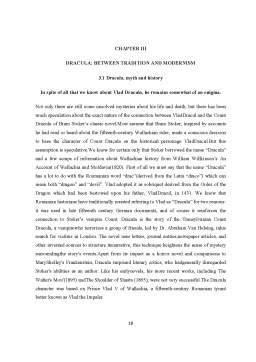Extras din licență
INTRODUCTION
When exploring the Gothic, it is difficult to isolate psychologicalfactors from social issues.In a form which focuses soclosely on complex models of identity it is not surprising that arange of different issues are addressed. However, arguably one of the most telling characteristics of the Gothic from the 1790s to the 1890s concerns the progressive internalization of ‘evil’.
It would bedangerous to generalize about this trend, but it would neverthelessbe true to say that a new focus on psychology indicates that a predominantlysecularized version of ‘monstrosity’ began to appear.Monsters are not, as they were with Walpole’s animated giants, orLewis’s demons, externally manifested sources of danger. Instead,by the mid-nineteenth century such horrors had largely been internalized.
The roots of this can be discerned in Frankenstein in thedoubling between Victor and his creature, but it is given freshimpetus in the mid-nineteenth century Gothic, as indicated by theemergence of the ghost story as a popular form from the 1840sonwards. Typically in the ghost story the ‘monster’ lives with you,invading your domestic spaces, so that ‘evil’ acquires a proximity tothe self which it did not necessarily have in the earlier Gothic. Thisnew departure is a matter of emphasis rather than a revolutionary break.The roots of this internalization of evil are to be found inmuch of the Romantic Gothic, whilst their mature development can be observed within the later Victorian Gothic.
On a formal level the Gothic typically transgresses models of realism by dwelling on fantastical experiences.On a more sophisticated level it also transgresses notions of conventional values, whether social, cultural, or sexual. However, often the transgressor (‘monster’, vampire, ghost, and so on) is associated with ‘evil’, which renders the moment ambivalent because of a hesitation between the pleasures of transgression and a demonizing language of ‘evil’.
The Gothic’s use of doubling is a clear indication of the internalization of ‘evil’. Indeed in the new, predominantly secularized context of the mid- to late nineteenth-century Gothic, ‘evil’ seems a misnomer because such ‘inner’ narratives can be explained in psychological and social, rather than strictly theological, terms.A post-Romantic conceptualization of unease which has played a significant role in the critical analysis of the Gothic was the “Uncanny”. Sigmund Freud’s essay ‘The Uncanny’ (1919) examined feelings of unease as they appear within seemingly commonplace experience.
Feelings of uncanniness (the unheimlich) are initially contrasted with ideas of the home (the heimlich) and the domestic security that it represents. However, the Oedipus complex suggests that the home is where sexual secrets are propagated, so that the home becomes traumatic, or uncanny, as a result. Freud initiallyregarded the double as indicating the emergence of our adult conscience.However, this ‘conscience’, which has a positive role in regulatingbehavior, turns into a dangerously powerful form ofcensorship that, for Freud, stifles the development of the self sothat the double becomes ‘the uncanny harbinger of death’because it psychologically kills (or represses) the self.This trauma is manifested as a repetition compulsion, and Freud explores how a culture repeats the past in tales of the dead in which the past comes back to life (or is repeated).
This conclusion has relevance for a consideration of the ghost story and the images of the double (the living and the dead) in the Gothic. Gothic so often focuses on issues of gender and identity it meansthat sexuality and politics are frequently foregrounded.Preeminent features of Gothic fiction include terror(both psychological and physical), mystery, the supernatural, ghosts, haunted houses and Gothicarchitecture, castles, darkness, death, decay, doubles, madness, secrets, and hereditary curses. The characters of Gothic fiction include tyrants, villains, bandits, maniac, persecuted maidens, madwomen, demons, fallen angels, and the Devil himself.Gothic literature has a long history behind it, and there are many books today still being written in that style.
CHAPTER I
GOTHIC LITERATURE
The Gothic was considered a predominantly prose form.However, the roots of the Gothic are to be found in earlier theatrical and poetic traditions. Radcliffe, for example, is heavily indebted to Shakespearean tragedy and in The Italian often begins her chapters with a quotation from his plays. However, her interrogation of Romantic concepts, such as the sublime and the role of nature, is firmly rooted in the poetry of the period. In addition the Gothic more generally owes some debt to the ‘Graveyard Poetry’ of the 1740s and 1750s. Edward’s Young’s Night Thoughts (1750-55), Robert Blair’s The Grave (1743), James Hervey’s Meditations amongthe Tombs (1745-47), Thomas Warton’sOn the Pleasures ofMelancholy (1747), and Thomas Gray’s Elegy written in a CountryChurchyard (1751) all made a significant contribution to developing a Gothic ambience (by dwelling on feelings of loss), and provided an investigation into life and death that constituted a peculiarly Gothic metaphysic. The Gothic novel’s link to Romantic poetry was noted by Sir Walter Scott when he proclaimed Radcliffe ‘the first poetess of romantic fiction’ . The Romantic interest in exploring non-rational (anti-Enlightenment) states led many of the Romantic poets to write in the Gothic mode. This explores how a Romantic Gothic tradition of poetry developed themes (concerning sexuality, art, and the imagination) which influenced a later poetic tradition here represented by Christina Rossetti’s Goblin Market (1862). It is important to note that after the Gothic heydayof the late eighteenth and early nineteenth centuries, the Gothicdoes not disappear but subversively infiltrates other forms ofwriting, including poetry, and the realist Victorian novel.
Preview document
Conținut arhivă zip
- Dracula.docx













































































